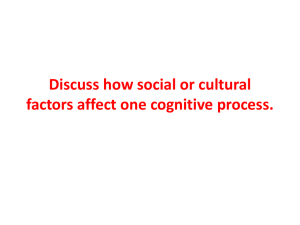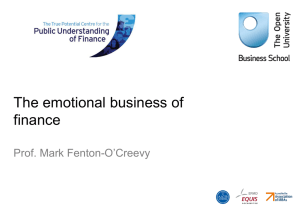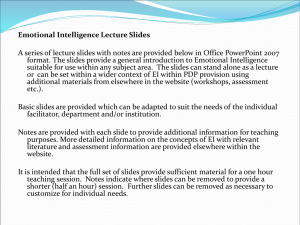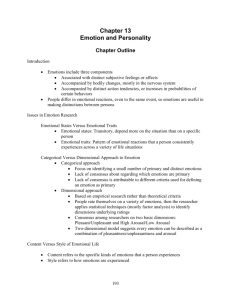Emotions
advertisement
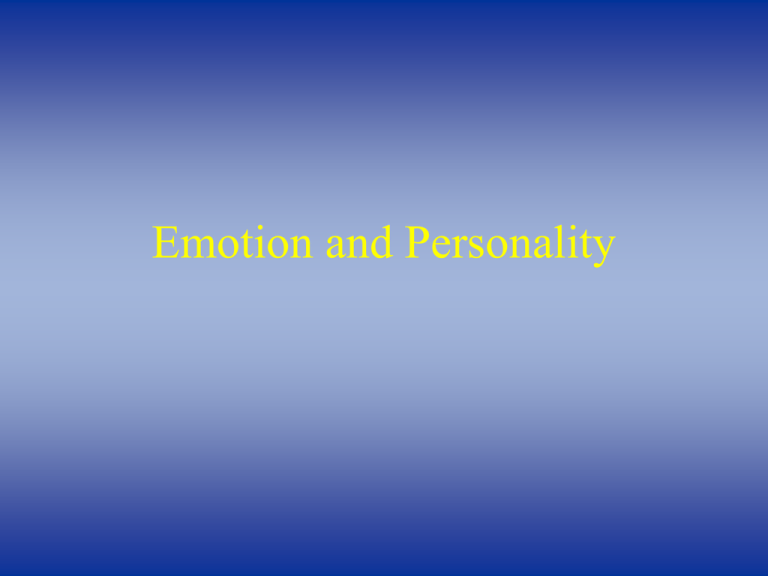
Emotion and Personality Emotions Components of Emotions (e.g., fear): Distinct subjective feelings (e.g., anxiety) Accompanied by bodily changes (e.g., increase heart rate) Accompanied by action tendencies, or increases in the probabilities of certain behaviors (tendency to fight or flight) Emotions • People differ in emotional reactions, even to the same event, so emotions are useful in making distinctions between persons Issues In Emotion Research Emotion States versus Emotion Traits Categorical Approach to Emotions versus Dimensional Approach The Content versus Style of Emotional Life Issues In Emotion Research Emotion States versus Emotion Traits Emotion states are transitory and depend more on the situation than on the specific person An emotional trait is a pattern of emotional reactions that a person consistently experiences across a variety of life situations Issues In Emotion Research Categorical Approach Dimensional Approach Emotions are a small number of primary and distinct emotions Emotions are broad dimensions of experience Anger, Joy, Anxiety Pleasant Unpleasant Issues In Emotion Research Content versus Style of Emotional Life Content: specific kinds of emotions Style: how emotions are experienced and expresses The Content of Emotional Life Pleasant Emotions versus Unpleasant Emotions The Content of Emotional Life Pleasant Emotions Pleasant emotions: Happiness and life satisfaction (Subjective Well-Being) Researchers have defined happiness in two complimentary ways: (1) Judgment that life is satisfying (2) Predominance of positive relative to negative emotions Happiness not just absence of negative emotions The Content of Emotional Life • Are self-reported happier people really happier? • Self-report and non-self-report measures of happiness correlate with self-report scores on social desirability – Part of being happy is to have positive illusions about the self, an inflated view of the self as a good, able, desirable person (Defense Mechanisms) The Content of Emotional Life Survey measures of happiness and well- being predict other aspects of people’s lives we would expect to relate to being happy Compared to unhappy people, happy people are less abusive, less hostile, report fewer diseases, are more helpful, creative, energetic, forgiving, and trusting Thus, self-reports of happiness are valid and trustworthy The Content of Emotional Life What We Know About Happy People No difference between the genders No difference between age groups; however, the circumstances that make us happy changes with age No differences with race or ethnicity The Content of Emotional Life • Money? – Within a country? – Over time? • • • • Education? Marriage? Children? Religion? The Content of Emotional Life Personality and Well Being Two personality traits that influence happiness Extraversion Neuroticism Two different models Indirect model: Personality causes a person to create a certain lifestyle, and lifestyle causes emotion reactions Direct model: Personality causes emotional reactions The Content of Emotional Life • Explanations – Goal Satisfaction vs. Activity (goal striving) – Top down (trait) vs. Bottom up (state) The Content of Emotional Life Unpleasant Emotions Trait anxiety, negative affectivity, or neuroticism Depression and melancholia Anger-proneness and hostility The Content of Emotional Life Anxiety, Negative Affectivity, or Neuroticism Eysenck’s Biological Theory Neuroticism is due primarily to the tendency of the limbic system in the brain to become easily activated The Content of Emotional Life Anxiety, Negative Affectivity, or Neuroticism Cognitive Theories Neuroticism is caused by styles of information processing—preferential processing of negative (but not positive) information about the self (not about others) Related explanation holds that high neuroticism people have richer networks of association surrounding memories of negative emotion— unpleasant material is more accessible The Content of Emotional Life Depression and Melancholia Beck’s Cognitive Theory Certain cognitive style is a pre-existing condition that makes people vulnerable to depression Depressive schemas for Self, World, Future Versus Depressive realism The Content of Emotional Life Anger-Proneness and Hostility Type A personality: Syndrome or a cluster of traits, including achievement strivings, impatience, competitiveness, hostility Research identified Type A personality as a predictor of heart disease Research subsequently identified hostility as a trait of Type A most strongly related to heart disease The Content of Emotional Life • Hostility: Tendency to respond to everyday frustrations with anger and aggression, to become easily irritated, to act in a rude, critical, antagonistic, uncooperative manner in everyday interaction • Hostility in Big Five: Low agreeableness, high neuroticism Emotional Style Affect Intensity as an Emotional Style Assessing Affect Intensity and Mood Variability Research Findings on Affect Intensity Emotional Style High Affect Intensity Low Affect Intensity Individuals who experience emotions strongly and are emotionally reactive and variable Individuals who experience emotions only mildly and with only gradual fluctuations Emotional Style Assessing Affect Intensity and Mood Variability Affect Intensity Measure Beeper studies Emotional Style Research Findings on Affect Intensity High affect intensity subjects tend to evaluate the events in their lives (both positive and negative) as having more emotional impact Individuals high on the affect intensity dimension exhibit more mood variability Affect intensity relates to the personality dimensions of high activity level, sociability, and arousability The Interaction of Content and Style in Emotional Life Hedonic balance interacts with affect intensity to produce specific types of emotional lives that may characterize different personalities Summary Emotions as States or as Traits Emotional Content Emotional Style

